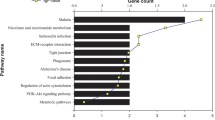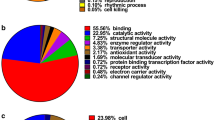Abstract
Purpose
The objective of this study was to identify differentially expressed proteins of advanced gastric cancer from patients with different prognosis using NanoLC–MS/MS (LTQ) (nanoflow liquid chromatography system interfaced with a linear ion trap LTQ mass spectrometer).
Methods
Eight gastric cancer patients with relatively early TNM stage and survival time >34 months were identified as good survival (group G), while the other eight with late stage and survival time <15 months as poor survival (group P). The total protein of the tissue samples from each group was extracted and pooled together respectively. The resulting two protein mixtures were trypsin-digested and analyzed using NanoLC–MS/MS (LTQ). Database searches were done against NCBI non-redundant database and SWISS-PROT database and the identified proteins were classified through an online Web Gene Ontology Annotation Plot tool. Immunohistochemistry was used to verify candidate prognosis-related proteins.
Results
There were 284 and 213 proteins identified for group G and group P respectively. And 117 proteins were detected exclusively in group G and 46 proteins exclusively in group P. These protein markers function in calcium ion signaling pathway, cellular metabolism, cytoskeleton formation, stress reaction, etc. Among those, the down-regulated expression of S100P was verified to claim a poor clinical outcome of gastric cancer patients (P = 0.0375).
Conclusion
The MS-based proteomics approach is efficient in identifying differentially expressed proteins in relation to prognosis of advanced gastric cancer patients. These differentially expressed proteins could be potential prognosis-related cancer markers and deserve further validation and functional study.



Similar content being viewed by others
Abbreviations
- NanoLC–MS/MS (LTQ):
-
Nanoflow liquid chromatography interfaced with a linear ion trap spectrometer
References
Akoh JA, Macintyre IM (1992) Improving survival in gastric cancer: review of 5-year survival rates in English language publications from 1970. Br J Surg 79:293–299
Allgayer H, Heiss MM, Schildberg FW (1997) Prognostic factors in gastric cancer. Br J Surg 84:1651–1664
Arumugam T, Simeone DM, Van Golen K, Logsdon CD (2005) S100P promotes pancreatic cancer growth, survival, and invasion. Clin Cancer Res 11:5356–5364
Bichat F, Mouawad R, Solis-Recendez G, Khayat D, Bastian G (1997) Cytoskeleton alteration in MCF7R cells, a multidrug resistant human breast cancer cell line. Anticancer Res 17:3393–3401
Chao A, Wang TH, Lee YS, Hsueh S, Chao AS, Chang TC, Kung WH, Huang SL, Chao FY, Wei ML, Lai CH (2006) Molecular characterization of adenocarcinoma and squamous carcinoma of the uterine cervix using microarray analysis of gene expression. Int J Cancer 119:91–98
Crnogorac-Jurcevic T, Missiaglia E, Blaveri E, Gangeswaran R, Jones M, Terris B, Costello E, Neoptolemos JP, Lemoine NR (2003) Molecular alterations in pancreatic carcinoma: expression profiling shows that dysregulated expression of S100 genes is highly prevalent. J Pathol 201:63–74
Dhanasekaran SM, Dash A, Yu J, Maine IP, Laxman B, Tomlins SA, Creighton CJ, Menon A, Rubin MA, Chinnaiyan AM (2005) Molecular profiling of human prostate tissues: insights into gene expression patterns of prostate development during puberty. Faseb J 19:243–245
Dowen SE, Crnogorac-Jurcevic T, Gangeswaran R, Hansen M, Eloranta JJ, Bhakta V, Brentnall TA, Luttges J, Kloppel G, Lemoine NR (2005) Expression of S100P and its novel binding partner S100PBPR in early pancreatic cancer. Am J Pathol 166:81–92
Emoto K, Sawada H, Yamada Y, Fujimoto H, Takahama Y, Ueno M, Takayama T, Uchida H, Kamada K, Naito A, Hirao S, Nakajima Y (2001) Annexin II overexpression is correlated with poor prognosis in human gastric carcinoma. Anticancer Res 21:1339–1345
Fan DM, Zhang XY, Chen XT, Mu ZX, Hu JL, Qiao TD, Chen BJ (1988) Mouse and human monoclonal antibodies against gastric cancer. Preparation and clinical application. Chin Med J (Engl) 101:488–489
Fukushima N, Sato N, Prasad N, Leach SD, Hruban RH, Goggins M (2004) Characterization of gene expression in mucinous cystic neoplasms of the pancreas using oligonucleotide microarrays. Oncogene 23:9042–9051
Guerreiro Da Silva ID, Hu YF, Russo IH, Ao X, Salicioni AM, Yang X, Russo J (2000) S100P calcium-binding protein overexpression is associated with immortalization of human breast epithelial cells in vitro and early stages of breast cancer development in vivo. Int J Oncol 16:231–240
Hofler H, Becker KF, Keller G (2003) Molecular carcinogenesis of the upper gastrointestinal tract. Verh Dtsch Ges Pathol 87:123–129
Hu L, Li X, Jiang X, Zhou H, Jiang X, Kong L, Ye M, Zou H (2007) Comprehensive peptidome analysis of mouse livers by size exclusion chromatography prefractionation and nanoLC–MS/MS identification. J Proteome Res 6:801–808
Ishihama Y (2005) Proteomic LC–MS systems using nanoscale liquid chromatography with tandem mass spectrometry. J Chromatogr A 1067:73–83
Katz A, Waridel P, Shevchenko A, Pick U (2007) Salt-induced changes in the plasma membrane proteome of the halotolerant alga Dunaliella salina as revealed by Blue-Native gel electrophoresis and nanoLC–MS/MS analysis. Mol Cell Proteomics 6:1459–1472
Lee HS, Lee HK, Kim HS, Yang HK, Kim WH (2003) Tumour suppressor gene expression correlates with gastric cancer prognosis. J Pathol 200:39–46
Lee CH, Lum JH, Cheung BP, Wong MS, Butt YK, Tam MF, Chan WY, Chow C, Hui PK, Kwok FS, Lo SC, Fan DM (2005) Identification of the heterogeneous nuclear ribonucleoprotein A2/B1 as the antigen for the gastrointestinal cancer specific monoclonal antibody MG7. Proteomics 5:1160–1166
Mori M, Shimada H, Gunji Y, Matsubara H, Hayashi H, Nimura Y, Kato M, Takiguchi M, Ochiai T, Seki N (2004) S100A11 gene identified by in-house cDNA microarray as an accurate predictor of lymph node metastases of gastric cancer. Oncol Rep 11:1287–1293
Roder DM (2002) The epidemiology of gastric cancer. Gastric Cancer 5(Suppl 1):5–11
Sanz-Ortega J, Steinberg SM, Moro E, Saez M, Lopez JA, Sierra E, Sanz-Esponera J, Merino MJ (2000) Comparative study of tumor angiogenesis and immunohistochemistry for p53, c-ErbB2, c-myc and EGFr as prognostic factors in gastric cancer. Histol Histopathol 15:455–462
Schafer BW, Wicki R, Engelkamp D, Mattei MG, Heizmann CW (1995) Isolation of a YAC clone covering a cluster of nine S100 genes on human chromosome 1q21: rationale for a new nomenclature of the S100 calcium-binding protein family. Genomics 25:638–643
Schlosser A, Vanselow JT, Kramer A (2005) Mapping of phosphorylation sites by a multi-protease approach with specific phosphopeptide enrichment and NanoLC–MS/MS analysis. Anal Chem 77:5243–5250
Shi Y, Hu W, Yin F, Sun L, Liu C, Lan M, Fan D (2004) Regulation of drug sensitivity of gastric cancer cells by human calcyclin-binding protein (CacyBP). Gastric Cancer 7:160–166
Sobin LH, Wittekind C (2002) TNM Classification of malignant tumor–6th edn. Wiley, New York
Taniguchi S (2005) Suppression of cancer phenotypes through a multifunctional actin-binding protein, calponin, that attacks cancer cells and simultaneously protects the host from invasion. Cancer Sci 96:738–746
Toquet C, Jarry A, Bou-Hanna C, Bach K, Denis MG, Mosnier JF, Laboisse CL (2007) Altered Calreticulin expression in human colon cancer: maintenance of Calreticulin expression is associated with mucinous differentiation. Oncol Rep 17:1101–1107
Tjalsma H, Pluk W, van den Heuvel LP, Peters WH, Roelofs R, Swinkels DW (2006) Proteomic inventory of “anchorless” proteins on the colon adenocarcinoma cell surface. Biochim Biophys Acta 1764:1607–1617
Wang KJ, Wang RT, Zhang JZ (2004) Identification of tumor markers using two-dimensional electrophoresis in gastric carcinoma. World J Gastroenterol 10:2179–2183
Wang G, Platt-Higgins A, Carroll J, Rudland S, Winstanley J, Barraclough R, Rudland PS (2006) Induction of metastasis by S100P in a rat mammary model and its association with poor survival of breast cancer patients. Cancer Res 66:1199–1207
Yamashita H, Kitayama J, Ishikawa M, Nagawa H (2007) Tissue factor expression is a clinical indicator of lymphatic metastasis and poor prognosis in gastric cancer with intestinal phenotype. J Surg Oncol 95:324–331
Yang L (2006) Incidence and mortality of gastric cancer in China. World J Gastroenterol 12:17–20
Ye J, Fang L, Zheng H, Zhang Y, Chen J, Zhang Z, Wang J, Li S, Li R, Bolund L, Wang J (2006) WEGO: a web tool for plotting GO annotations. Nucleic Acids Res 34 (Web server issue):W293–W297
Yeates LC, Powis G (1997) The expression of the molecular chaperone calnexin is decreased in cancer cells grown as colonies compared to monolayer. Biochem Biophys Res Commun 238:66–70
Zech VF, Dlaska M, Tzankov A, Hilbe W (2006) Prognostic and diagnostic relevance of hnRNP A2/B1, hnRNP B1 and S100 A2 in non-small cell lung cancer. Cancer Detect Prev 30:395–402
Zhao Y, Jiang Y, Wang R, Zheng X, Wang X, Jin B, Lu Y, Qiao T, Hong L, Fan D (2007) Expression and prognostic value of MG7-Ag in patients with surgically resectable esophageal squamous cell carcinoma. Ann Surg Oncol 14:2621–2627
Zheng L, Wang L, Ajani J, Xie K (2004) Molecular basis of gastric cancer development and progression. Gastric Cancer 7:61–77
Zhong XY, Zhang LH, Jia SQ, Shi T, Du H, Hu Y, Zhang GG, Lu AP, Li JY, Ji JF (2007) Nuclear expression of S100A4 is associated with lymph node metastasis in gastric carcinoma. Zhonghua Wei Chang Wai Ke Za Zhi 10:454–457
Acknowledgments
This work was supported by the National Natural Science Foundation of China (No. 30571807) and the Foundation of Beijing Municipal Committee of Science & Technology, China (No. D0905001040631). We are grateful to Ph.D Yang Shuang, Beijing Genomics Institute, China, for WEGO plot making.
Author information
Authors and Affiliations
Corresponding author
Additional information
S.-Q. Jia and Z.-J. Niu contributed equally to this study.
Rights and permissions
About this article
Cite this article
Jia, SQ., Niu, ZJ., Zhang, LH. et al. Identification of prognosis-related proteins in advanced gastric cancer by mass spectrometry-based comparative proteomics. J Cancer Res Clin Oncol 135, 403–411 (2009). https://doi.org/10.1007/s00432-008-0474-3
Received:
Accepted:
Published:
Issue Date:
DOI: https://doi.org/10.1007/s00432-008-0474-3




